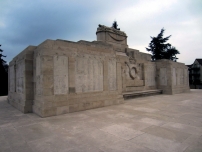| First Name: | John William | Last Name: | JONES | |
|---|---|---|---|---|
| Date of Death: | 24/08/1914 | Lived/Born In: | Pimlico | |
| Rank: | Sergeant | Unit: | Lancers9 | |
| Memorial Site: | La Ferte-sous-Jouarre Memorial, France | |||
Current Information:
Enlisted-London
The Battle of Mons August 23, 1914 This was the first battle fought by the British Army (BEF) in the war. Since landing in France ten days earlier the four infantry divisions and five cavalry brigades of the BEF had advanced to a position on the left flank of the French Armies only to find themselves directly in the line of the advance of the German First Army as they swept through Belgium and headed for Paris. With orders to hold the German advance for 24 hours and outnumbered two to one, the BEF dug in along the Mons-Conde canal. The battle commenced at 9 am and lasted all day. By nightfall the BEF had withdrawn to the Valenciennes-Maubeuge road, a position from which the Great Retreat began the next day. British casualties, killed, wounded or missing, amounted to 1600 for the battle. German casualties were higher. On 24th August, the day after the Battle of Mons, the of 2nd Cavalry Brigade used the sunken roads and slag heaps along the Mons-Valenciennes road, to delay the Germans. In what has been called ‘an extraordinary piece of folly, even by the standards of the British cavalry’*, the 18th Hussars, 9th Lancers and 4th Dragoon Guards moved up to positions near Élougies. From here the 9th Lancers attacked north at the gallop, across a mile of open ground, to take the Germans in the flank with two troops of 4th Dragoon Guards echeloned to their left rear. They crossed the Baisieux-Élouges road but here their advance was checked by German field artillery batteries. Some dismounted by the Sugar Factory, others swept round to the right and back to Audregnies but most retired along the mineral railway towards Élouges where they rallied on 18th Hussars. A squadron of 4th Dragoon Guards galloped down a narrow lane towards Baisieux to seize a house and cover a further advance on Quiévrains. They were badly hit by rifle and shrapnel but managed to reach the cottage. Later they withdrew from the house at Baisieux and along with the main body of 2nd Cavalry Brigade moved south-west to Ruesnes. Among the casualties suffered by the 2nd Cavalry Brigade during the fighting on this day was John Jones of 9th Lancers.
*‘Catastrophe’ Max Hastings p.215
|
||||
| « Back to Search Results | ||||
| If you think any of the information shown here is incorrect, Click Here to submit your amends and comments | ||||




